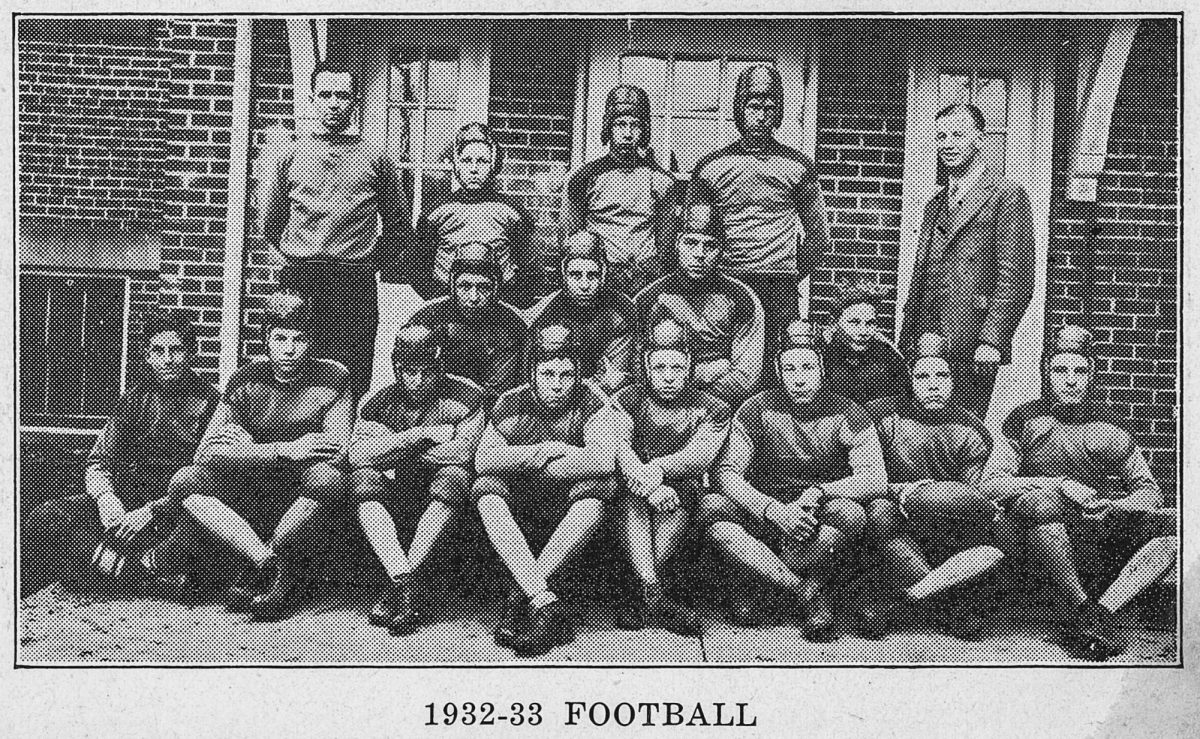
EDITOR’S NOTE: This story originally appeared in a special publication marking the 100th anniversary of Menomonie High School football in 1995. It was reprinted in the Dunn County Historical Society Newsletter in 2024. This updated version reflects additional context and remains a tribute to a unique chapter of Dunn County’s sports history.
Aggie’s short-lived football program left lasting memories
At the Dunn County School of Agriculture and Domestic Economy, better known as “Aggie,” students weren’t just learning the three Rs. Their curriculum also included how to dress chickens, which seeds would produce the best crops and how to keep a tractor running.
And for a brief but memorable stretch in the 1930s, they also learned how to play football.
Aggie launched its football program in 1932. According to former player Truman Torgerson, a farm boy from Meridean, that first season was rough: the purple-and-white squad won just once, 7-0 over Eau Claire Junior High.
The program’s unlikely leader was William “Bill” Bundy, a Menomonie attorney who had earned a reputation as a star athlete at Menomonie High School in the 1920s. Bundy, along with school superintendent Randall Swanson and assistant coach John Knapp, convinced Stout Institute’s coach Earl Burbridge to donate the school’s old football uniforms.
Bundy’s support staff was just as homegrown. Knapp, John Harmon of “Harmon’s Chicken Dinner” fame and Dr. Quilling, the team physician, all volunteered their time to keep Aggie football alive.
Torgerson, who would later win the 1939 NCAA light-heavyweight boxing championship for the University of Wisconsin, praised Bundy in his memoir Digging Up the Past.
“Our coach, Bill Bundy, a local attorney, was a scrub quarterback for the University of Wisconsin. He was a small man, weighing 125 pounds, but smart, had a great voice and a will to win,” Torgerson wrote. “He was an all-star performer, taking a bunch of farm lads, many who had never had a football in their hands before, and developed them into a champion in three years. He sacrificed a lot of time from his law practice that we might have a team.”
Bundy’s methods were resourceful. He nicknamed one player “Triple Threat” Boettcher – adding with a wink, “Slip, slide and stumble.” Each fall he organized a weeklong preseason training camp at his cottage on the Red Cedar River, charging each player a $5 fee despite the hard times of the Great Depression.
Not every family could afford it. Torgerson recalled that quarterback Rueben Retz made camp only because his father substituted two bags of potatoes for the fee. Bundy saw Retz’s potential, pulling him from the line to make him quarterback.
“Retz, I want you to be my quarterback,” Bundy reportedly told him. Before each game, Bundy drove Retz around to calm him down and map out strategy. Retz eventually became a steady leader, earning the respect of his teammates.
The Aggies didn’t look like much at first. Their debut against Boyceville was a learning experience, Torgerson remembered.
“We were a motley looking group wearing hand-me-down gear from Stout that hung mighty loose on all of us,” he wrote. On the team’s first play, Bundy called for a pass. The play worked, but instead of blocking, the rest of the Aggies stood still shouting, “Run, Fred, run!” A sure touchdown turned into a missed opportunity.
Despite those growing pains, Bundy’s persistence paid off. After going 1-3-0 in 1932 and 0-2-3 in 1933, the Aggies captured the Dunn-St. Croix Conference championship in 1934 with a 4-2-0 record. They sealed the crown with a 25-0 win over Boyceville, the same school that had humbled them just two years earlier.
That 1934 team included Retz at quarterback, halfback Francis Grimme, center Lloyd Confer and running back Malcolm McLain, who later played professionally for Milwaukee and Buffalo of the American Football League before a knee injury ended his career.
Torgerson described McLain as a “shifty runner with considerable passing ability,” Confer as a “stellar performer who could clog up the middle,” and Grimme as “one quick, rough and tough player who gave us the extra yards when needed.”
Aggie repeated as Dunn-St. Croix champions in 1935 with a 6-1-0 record behind standouts Harold Kruetzer and Barney Gebhardt. By then, Torgerson had been shifted to his third different position, a testament both to Bundy’s adaptability and the team’s limited roster.
But the good years were fleeting. The program slipped in the late 1930s. By 1937 Aggie switched to eight-man football, and by 1940, the program was dropped altogether.
For just eight seasons, Aggie football brought small-town grit and big memories to Dunn County. Players wore oversized hand-me-down uniforms, trained at a lawyer’s riverside cottage and sometimes paid their way in potatoes. But under Bundy’s guidance, they grew into champions – and part of a story still worth telling nearly a century later.
Dunn County School of Agriculture (Aggie) Football Records
1932 – 1-3-0
1933 – 0-2-3
1934 – 4-2-0 * (Dunn-St. Croix champion)
1935 – 6-1-0 * (Dunn-St. Croix champion)
1936 – 2-3-0
1937 – 1-3-0
1938 – 0-6-0
1939 – 1-5-0
Layne Pitt is the retired UW-Stout sports information director and also worked more than a decade at The Dunn County News.
Aggies Unlikely Run by Layne Pitt is licensed under a CC BY SA 4.0 International license. https://creativecommons.org/licenses/by-sa/4.0/
Menomonie Mustangs Athletics and Activities | UW-Stout Blue Devil Athletics